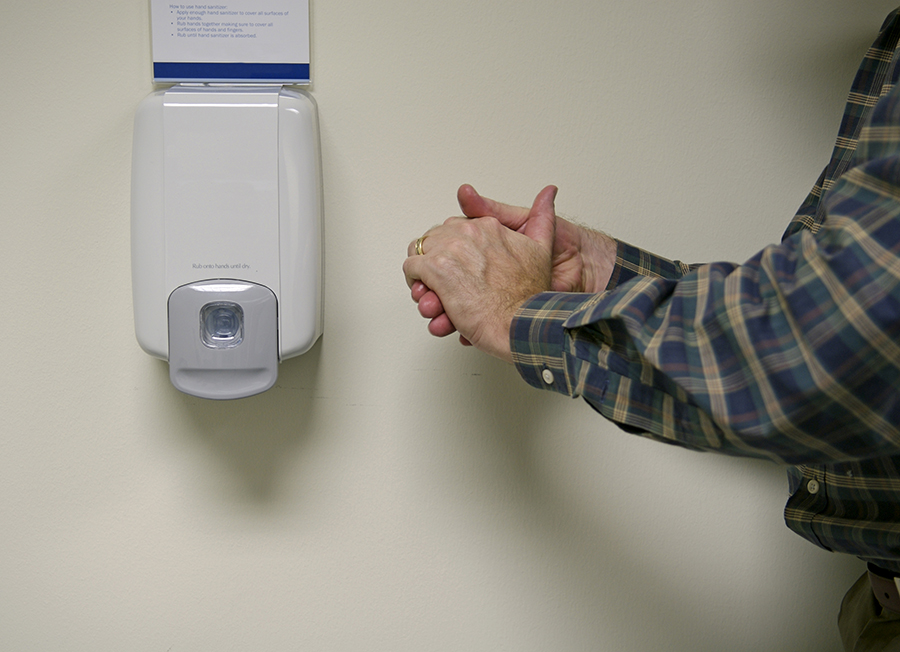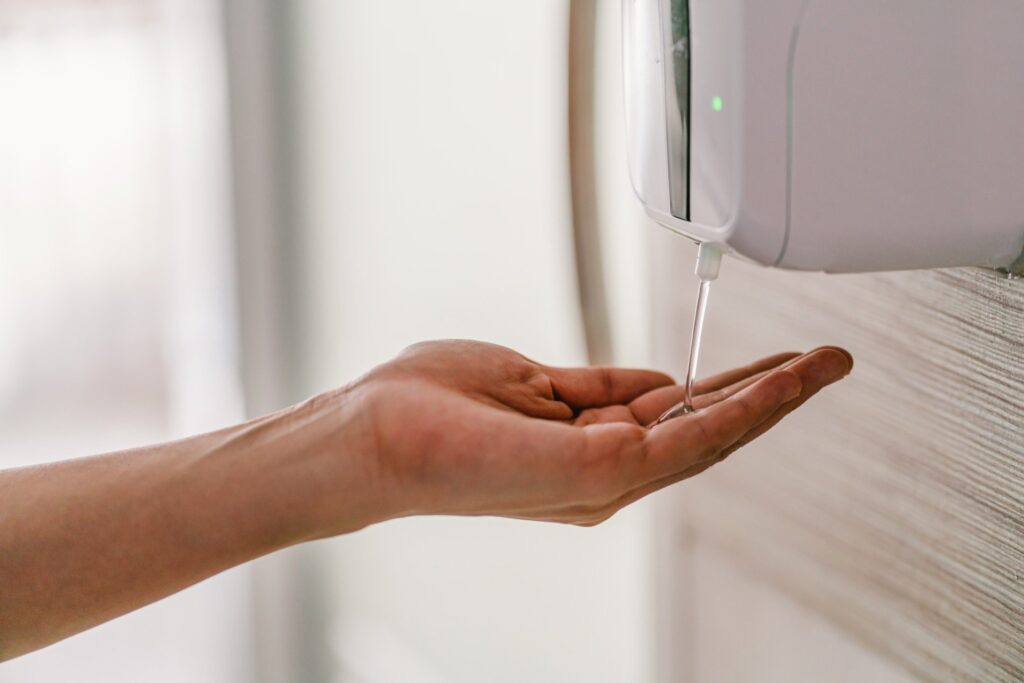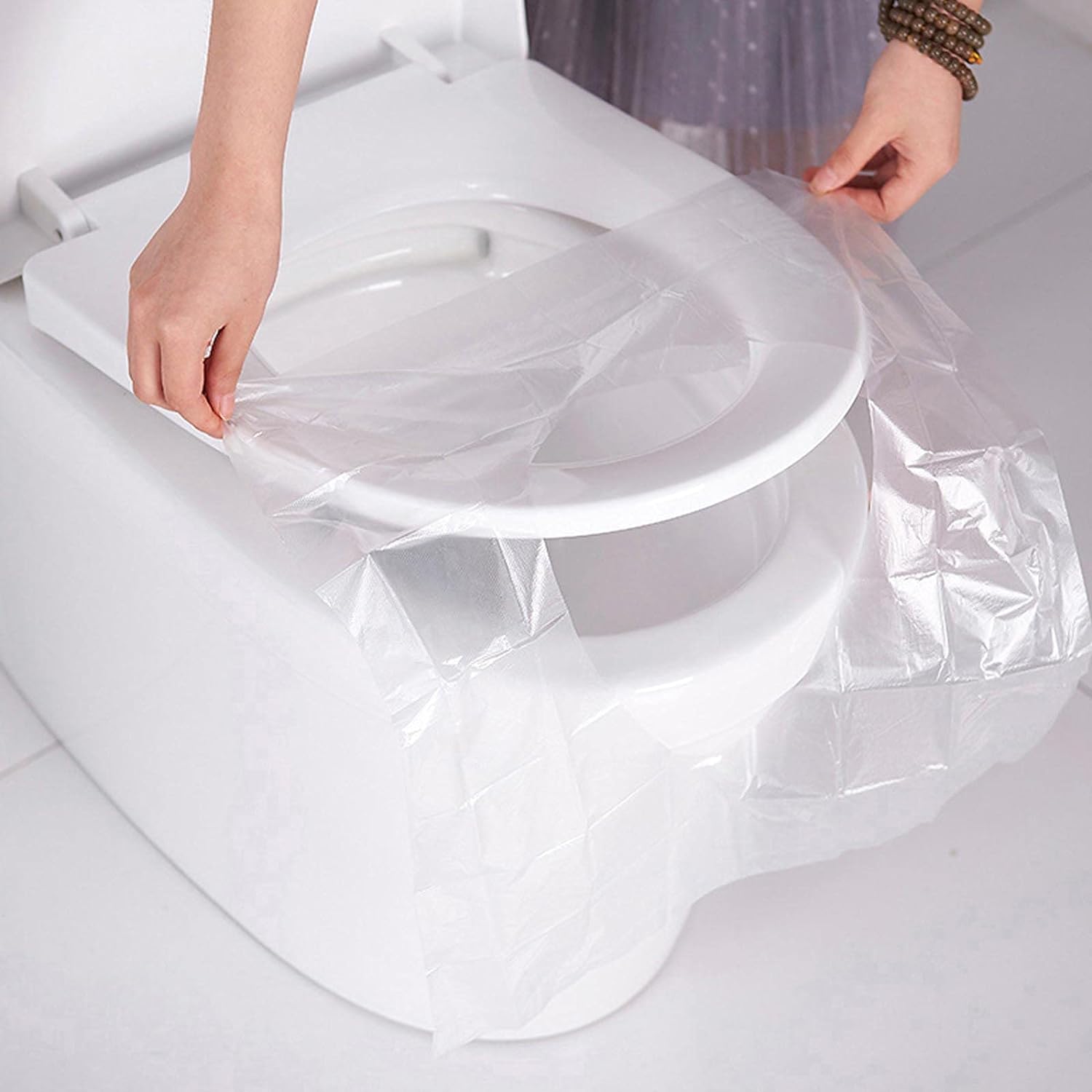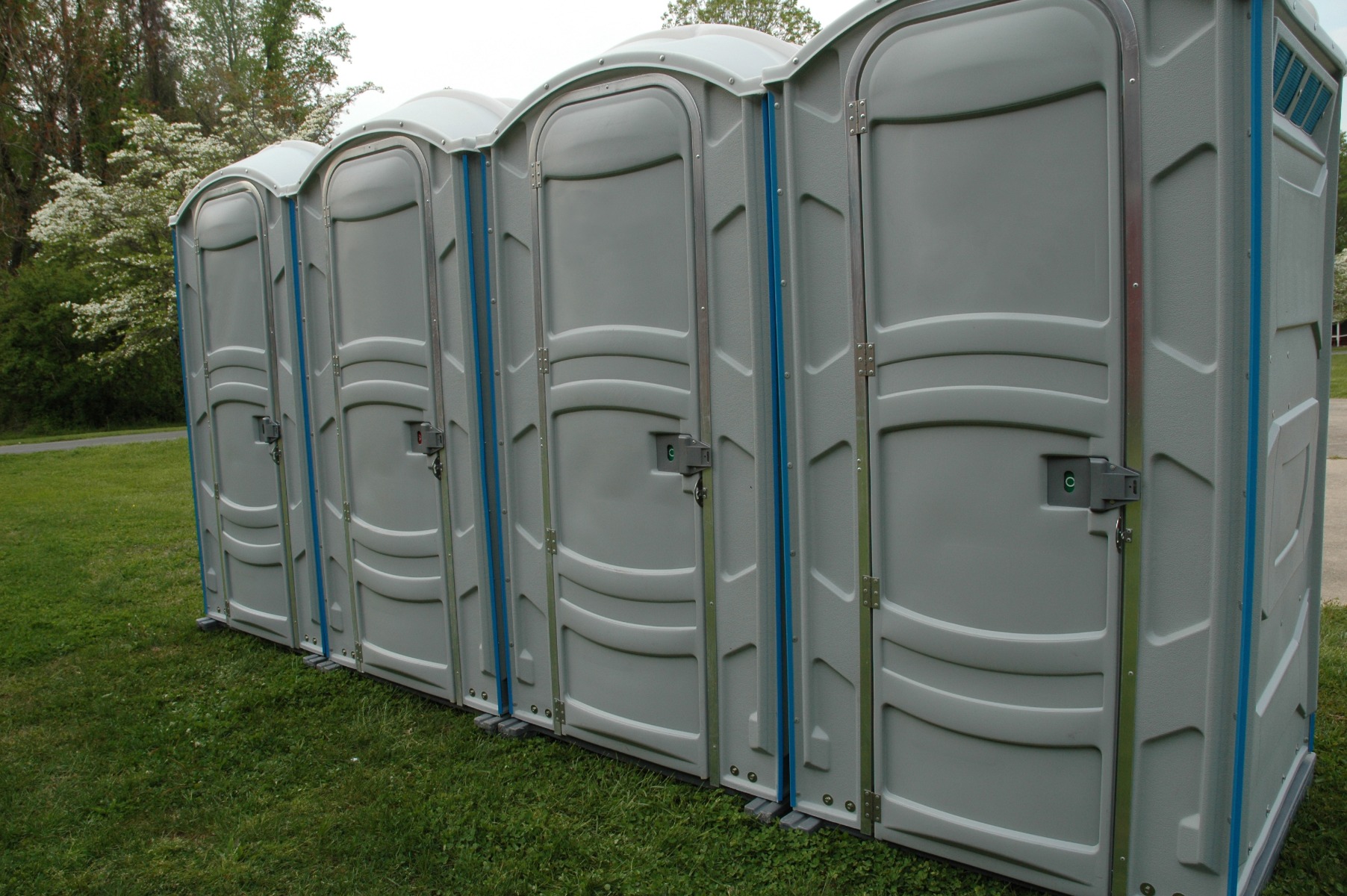Portable restrooms have become an essential component of various outdoor events, construction sites, and public spaces. With the convenience they offer, it is crucial to prioritize safety measures to ensure hygienic conditions for users. One notable example that illustrates the significance of such precautions is a case study conducted at a music festival where inadequate sanitation facilities resulted in a widespread outbreak of gastrointestinal illnesses among attendees. In light of this incident, it becomes imperative to explore effective safety precautions associated with portable restroom rentals and hand sanitizer usage.
To begin with, proper maintenance and regular cleaning are fundamental aspects when considering the safety of portable restrooms. Rental companies should adhere to strict guidelines regarding cleanliness and hygiene standards by regularly disinfecting these facilities. This not only helps eliminate harmful bacteria but also prevents the spread of diseases. Additionally, ensuring an adequate supply of toilet paper, soap dispensers, and functioning handwashing stations within these units is vital to promote good hygiene practices among users.
Furthermore, the use of hand sanitizers plays a significant role in preventing infections and maintaining overall cleanliness in portable restrooms. Hand sanitizers containing at least 60% alcohol effectively kill most types of germs present on hands when washing with soap and water is not feasible. Encouraging individuals to sanitize their hands before and after using the portable restrooms can greatly reduce the risk of transmitting harmful pathogens. Placing hand sanitizer dispensers near the entrance or inside each unit can serve as a reminder for users to practice proper hand hygiene.
In addition to regular cleaning and hand sanitizer usage, there are other safety precautions that can be implemented for portable restrooms. These include:
- Adequate ventilation: Proper ventilation helps reduce odors, maintain air quality, and prevent the buildup of harmful gases within the units. Rental companies should ensure that their portable restrooms have adequate ventilation systems in place.
- Regular inspections: Regular inspections of portable restrooms can help identify any maintenance or repair needs promptly. This includes checking for leaks, malfunctioning toilets or sinks, and any potential hazards within the units.
- Secure placement: Portable restrooms should be securely placed on stable ground to prevent tipping or shifting during use. Ensuring they are properly anchored or stabilized will enhance user safety.
- Signage: Clear signage should be placed around portable restrooms to provide instructions on proper usage and highlight any safety precautions that need to be followed by users.
- Accessibility considerations: Portable restrooms should also cater to individuals with disabilities by providing accessible units that comply with relevant accessibility standards.
By implementing these safety precautions, rental companies and event organizers can create a safer environment for users of portable restrooms, reducing the risk of illnesses and promoting overall hygiene at outdoor events, construction sites, and public spaces.
Importance of Safety Measures
Importance of Safety Measures
Imagine attending a crowded outdoor event on a scorching summer day. The heat is intense, and you find yourself in need of restroom facilities. Fortunately, there are portable restrooms available nearby. However, have you ever stopped to consider the importance of safety measures when it comes to using these temporary facilities? Let’s explore this topic further.
Ensuring the safety and well-being of individuals at events or construction sites where portable restrooms are required is crucial. One case study that exemplifies the significance of implementing safety precautions involves an outdoor music festival held last year. With thousands of attendees gathered in one location, organizers had provided numerous portable restrooms throughout the venue. Unfortunately, due to inadequate sanitation practices, an outbreak of gastrointestinal illness occurred among festival-goers who utilized these unsanitary facilities.
To prevent such incidents from happening again, it is essential to follow specific safety measures when utilizing portable restrooms:
- Regularly sanitize hands with hand sanitizer before and after using the facility.
- Avoid touching surfaces inside the restroom as much as possible.
- Dispose of waste properly by following instructions provided within the restroom.
- Maintain cleanliness within the unit by avoiding littering or vandalizing.
By adhering to these guidelines, we can contribute to creating a safer environment for everyone involved. To emphasize their importance visually, let’s take a look at the following table illustrating potential health risks associated with improper usage and maintenance of portable restrooms:
| Potential Health Risks | Causes | Consequences |
|---|---|---|
| Bacterial Infections | Lack of sanitization | Gastrointestinal illnesses |
| Fungal Infections | Damp conditions | Skin irritations |
| Viral Outbreaks | Contaminated surfaces | Respiratory infections |
| Vector-Borne Diseases | Poor waste disposal | Mosquito-borne illnesses |
As we can see, neglecting safety measures when using portable restrooms can lead to various health risks. It is imperative for event organizers and individuals alike to prioritize the implementation of proper sanitation practices.
In light of these considerations, it becomes evident that ensuring the safety of those utilizing portable restrooms goes beyond mere convenience. In the subsequent section, we will explore another vital aspect: the proper placement of portable restrooms within an event or construction site environment. By strategically positioning these facilities, we can enhance accessibility and further contribute to a safe and well-organized space
Proper Placement of Portable Restrooms
Transitioning from the importance of safety measures, it is crucial to consider the proper placement of portable restrooms. This section will outline key factors to take into account when positioning these facilities at an event or construction site.
Imagine a bustling outdoor music festival with thousands of attendees. Ensuring that portable restrooms are strategically placed throughout the venue can significantly enhance the overall experience for participants. For instance, locating restroom units near high-traffic areas such as food stalls and stages not only saves time but also reduces instances of overcrowding in specific sections of the festival grounds.
To further emphasize the significance of optimal placement, let’s explore some essential considerations:
- Accessibility: Positioning portable restrooms within close proximity to main entrances and exit points ensures easy access for all attendees, including individuals with disabilities.
- Visibility: Placing signage directing visitors towards restroom facilities can help prevent confusion and minimize unnecessary foot traffic.
- Sufficient Distance: It is important to maintain a reasonable distance between portable restrooms and other event attractions to avoid unpleasant odors or noise disruption.
- Adequate Lighting: If the event extends into nighttime hours, ensuring proper lighting around restroom units enhances visibility and helps promote a sense of security.
| Consideration | Impact |
|---|---|
| Accessibility | Provides equal opportunity for all attendees |
| Visibility | Reduces confusion and minimizes unnecessary foot traffic |
| Sufficient Distance | Prevents discomfort caused by odor or noise disturbance |
| Adequate Lighting | Enhances safety, particularly during nighttime activities |
By carefully considering these factors, event organizers and construction site managers can ensure that portable restrooms are optimally placed to meet the needs of all participants. This attention to detail contributes to an overall positive experience for attendees and enhances their perception of safety at the venue.
Transitioning smoothly into the subsequent section on regular cleaning and maintenance, it is imperative to address how these aspects play a crucial role in maintaining cleanliness and hygiene within portable restroom facilities.
Regular Cleaning and Maintenance
Having discussed the importance of proper placement for portable restrooms, let us now turn our attention to another critical aspect of ensuring the safety and hygiene of these facilities – regular cleaning and maintenance. To illustrate its significance, consider a hypothetical scenario where an event organizer neglects routine upkeep of portable restrooms, resulting in unsanitary conditions that pose health risks to attendees.
Neglecting regular cleaning and maintenance can lead to various issues that compromise the well-being of users. For instance, when waste containers are not emptied promptly or frequently enough, they may overflow, creating unhygienic conditions within the restroom unit itself. This can result in foul odors permeating the area, attracting pests like flies and rodents which further exacerbate sanitation concerns. Moreover, inadequate cleaning practices can allow harmful bacteria to proliferate on surfaces such as toilet seats, door handles, and other high-touch areas.
To ensure the ongoing cleanliness and functionality of portable restrooms, it is essential to adhere to a comprehensive cleaning schedule. Here are some key considerations for effective maintenance:
- Frequent emptying of waste containers: Regularly emptying waste containers minimizes the risk of overflowing and maintains a clean environment.
- Thorough disinfection procedures: Employing appropriate disinfectants helps eliminate germs from surfaces regularly touched by users.
- Restocking essential supplies: Ensuring an ample supply of toilet paper, hand sanitizer, soap dispensers with liquid soap, and trash bags is vital for maintaining user satisfaction.
- Inspection for damages: Routinely inspecting units allows prompt identification and repair of any damage or malfunction that could compromise user safety.
By implementing these measures consistently throughout an event or rental period, organizers can uphold high standards of cleanliness, reducing the potential transmission of illnesses and enhancing user experience.
| Key Considerations for Regular Cleaning and Maintenance |
|---|
| Frequent emptying of waste containers |
The consequences of neglecting regular cleaning and maintenance are far-reaching. Not only does it result in unhygienic conditions that may lead to illness, but it also diminishes the overall experience for attendees. By prioritizing these crucial aspects, event organizers can create a safer and more enjoyable environment for all participants.
Moving forward, let us now explore another vital safety precaution related to portable restrooms: the provision of adequate ventilation.
Provision of Adequate Ventilation
Regular Cleaning and Maintenance
Ensuring the regular cleaning and maintenance of portable restrooms is crucial to maintaining a safe and hygienic environment for users. By implementing effective cleaning protocols, potential health risks can be minimized, ensuring that these facilities are safe for public use.
One example highlighting the importance of regular cleaning and maintenance involves a music festival where several portable restrooms were provided for attendees. Due to inadequate cleaning practices, the restrooms quickly became unsanitary, leading to an outbreak of gastrointestinal illnesses among festival-goers. This unfortunate incident underscores the need for proper cleaning procedures in order to prevent such occurrences.
To effectively maintain cleanliness, consider the following measures:
- Frequent disinfection: Regularly sanitize all surfaces within the portable restroom using appropriate disinfectants.
- Trash removal: Ensure that waste receptacles are emptied regularly to avoid overflow or unpleasant odors.
- Restock supplies: Check and replenish essential items like toilet paper, soap dispensers, and hand sanitizers on a routine basis.
- Inspection: Conduct thorough inspections after each use to identify any damages or issues that require immediate attention.
In addition to these measures, it is important to establish a schedule for deep cleaning and servicing based on usage patterns. This will help ensure that all areas of the portable restroom receive adequate attention and minimize the risk of contamination.
| Risk Factors | Preventive Measures | Potential Consequences |
|---|---|---|
| Lack of sanitation | Frequent disinfection | Spread of infections |
| Inadequate waste management | Regular trash removal | Unpleasant odor |
| Insufficient supplies | Restocking essentials | User dissatisfaction |
| Neglected maintenance | Thorough inspection | Increased risk of damage |
By adhering to these preventive measures and being mindful of potential consequences associated with poor upkeep, event organizers can provide a safe and clean environment for portable restroom users.
Moving forward, we will now explore the importance of ensuring hand hygiene in conjunction with regular cleaning and maintenance.
Ensuring Hand Hygiene
Transitioning seamlessly from the previous section, it is essential to emphasize the significance of maintaining proper hand hygiene when utilizing portable restroom rentals. By doing so, individuals can effectively minimize the spread of germs and protect their health within these facilities. For instance, imagine a scenario where a large outdoor event takes place, attracting thousands of attendees. Without ensuring adequate hand hygiene practices in portable restrooms, there is an increased risk of contagious illnesses spreading among participants.
To promote better hand hygiene, consider the following precautions:
- Provide accessible handwashing stations with running water and liquid soap.
- Install alcohol-based hand sanitizers as an alternative option for individuals who cannot access or use traditional handwashing facilities.
- Display clear signage that encourages visitors to wash their hands thoroughly after using the restroom.
- Regularly replenish supplies such as soap and paper towels to ensure availability throughout the event.
In addition to these measures, incorporating visual aids can further enhance awareness about proper hand hygiene. The table below highlights four key benefits associated with diligent handwashing:
| Benefits |
|---|
| Reduces transmission of harmful bacteria |
| Prevents the spread of infectious diseases |
| Promotes personal well-being |
| Protects overall public health |
By presenting this information in an easily digestible format, we aim to evoke an emotional response regarding the importance of practicing good hand hygiene at all times.
As we move forward in our discussion on safety precautions related to portable restroom rentals, it is crucial to address another critical aspect – disposal of waste materials. This ensures not only cleanliness but also minimizes potential health risks associated with improper handling and containment methods.
Disposal of Waste Materials
To further enhance the safety measures in place when utilizing portable restroom rentals, it is crucial to prioritize hand hygiene. Proper handwashing techniques and the availability of hand sanitizers play a vital role in preventing the spread of germs and maintaining overall cleanliness.
For instance, let’s consider an outdoor event where multiple portable restrooms are provided for attendees. In this scenario, individuals may come into contact with various surfaces within these facilities, making proper hand hygiene even more essential. By implementing effective practices such as regular handwashing and providing access to hand sanitizers, organizers can significantly reduce the risk of contamination and promote a safe environment for all participants.
To ensure optimal hand hygiene while using portable restrooms, consider the following precautions:
- Prominently display educational signage on how to properly wash hands.
- Provide adequate supplies such as soap dispensers or liquid soap.
- Install touchless faucets or foot-operated sinks to minimize surface contact.
- Supply alcohol-based hand sanitizers near entry/exit points.
By adhering to these precautions, participants will have clear guidance on maintaining proper hand hygiene throughout their use of portable restroom facilities.
Additionally, it is important to highlight key considerations regarding waste disposal from portable restrooms. The responsible management of waste materials not only ensures sanitation but also contributes to environmental sustainability.
Consider the following table outlining best practices for waste disposal:
| Waste Disposal Best Practices |
|---|
| – Use designated trash receptacles for non-flushable items |
| – Educate users about prohibited items through signage |
| – Regularly empty and clean waste tanks by trained professionals |
| – Dispose of waste at authorized treatment facilities |
Following these guidelines mitigates potential health risks associated with improper waste management and promotes environmentally friendly practices.
In summary, prioritizing proper hand hygiene coupled with appropriate waste disposal procedures enhances overall safety during the utilization of portable restroom rentals. By implementing educational initiatives, providing necessary supplies, and emphasizing responsible waste management, event organizers can create a hygienic environment that ensures the well-being of all participants.






